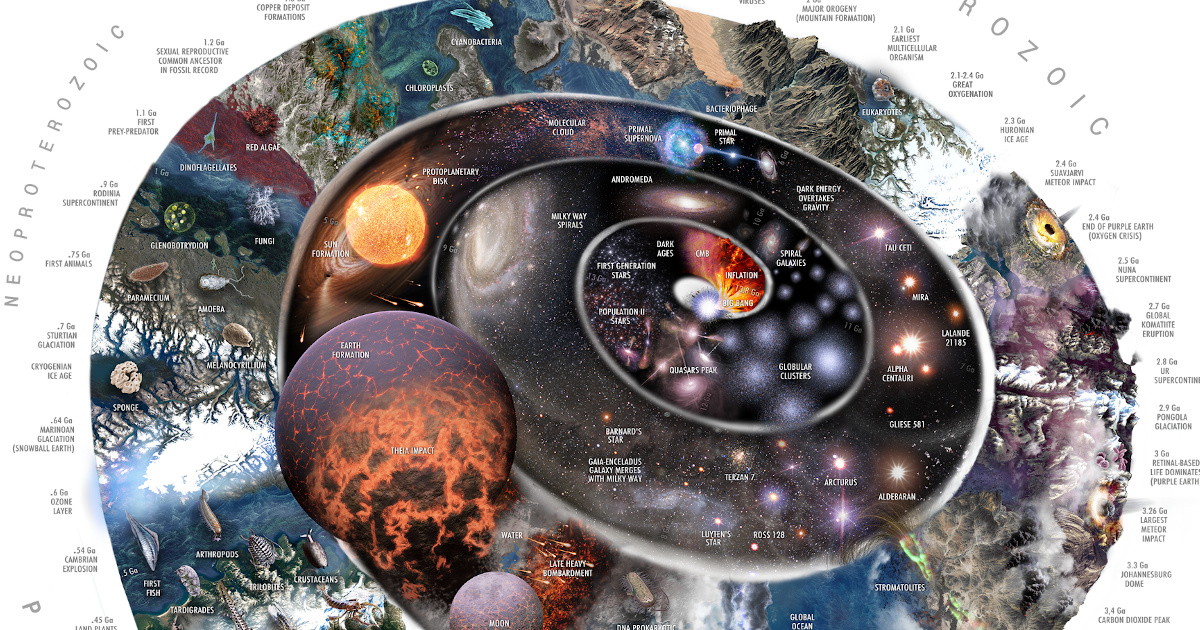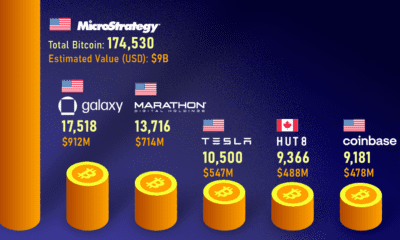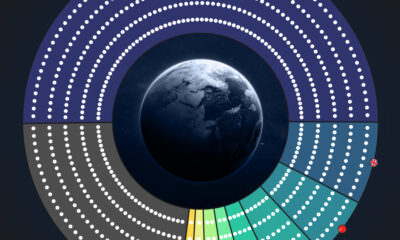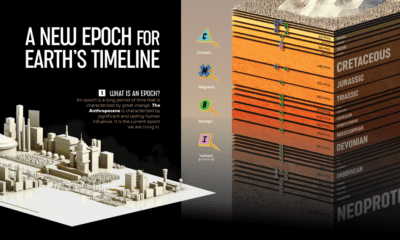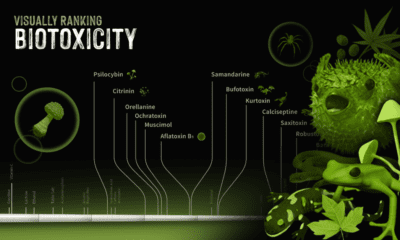Space
Nature Timespiral: The Evolution of Earth from the Big Bang
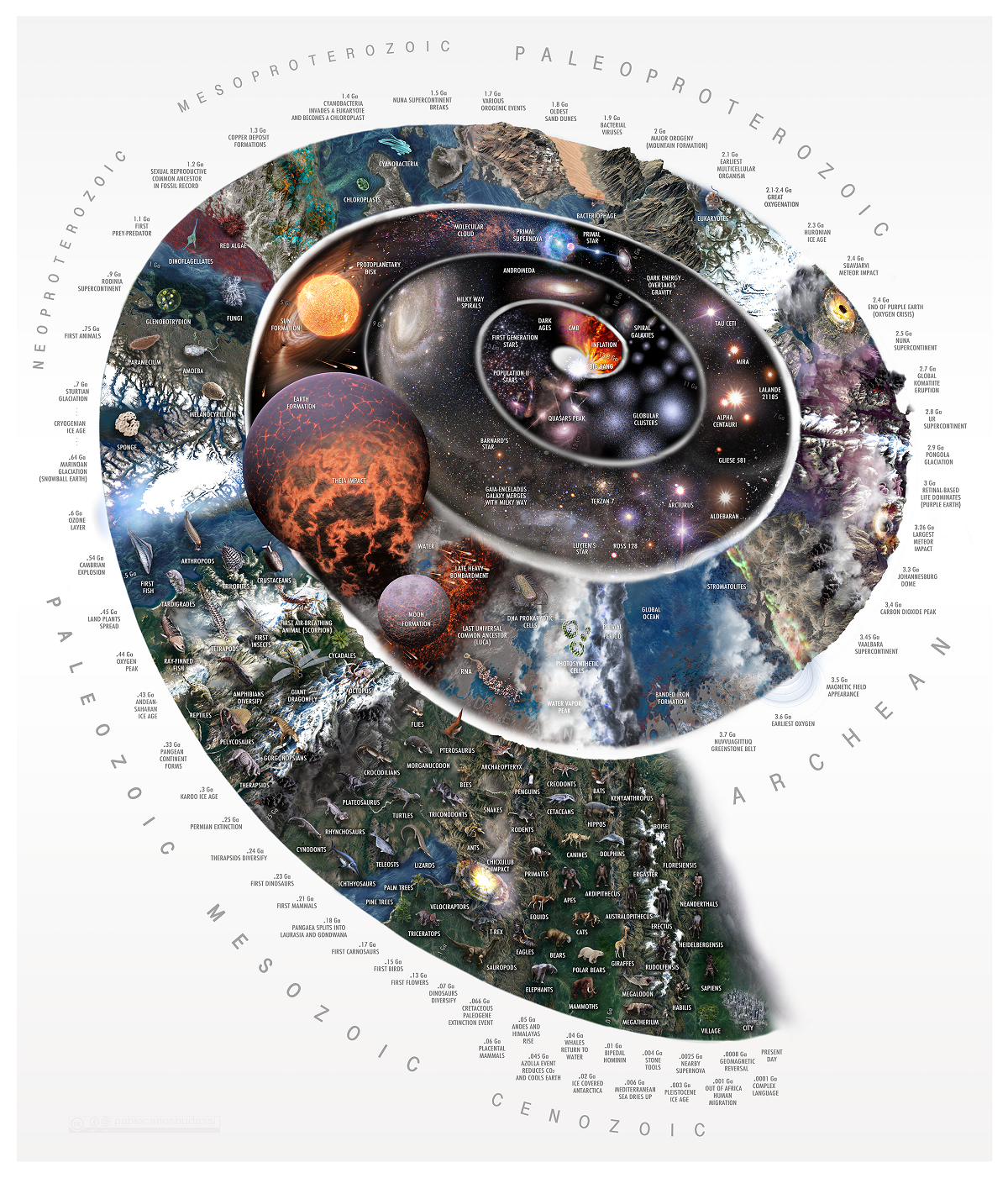
Click to view a larger version of the graphic. For a full-size option or to inquire about posters, please visit Pablo Carlos Budassi’s website.
Nature Timespiral: The Evolution of Earth from the Big Bang
Since the dawn of humanity, we have looked questioningly to the heavens with great interest and awe. We’ve called on the stars to guide us, and have made some of humanity’s most interesting discoveries based on those observations. This also led us to question our existence and how we came to be in this moment in time.
That journey began some 14 billion years ago, when the Big Bang led to the universe emerging from a hot, dense sea of matter and energy. As the cosmos expanded and cooled, they spawned galaxies, stars, planets, and eventually, life.
In the above visualization, Pablo Carlos Buddassi illustrates this journey of epic proportions in the intricately designed Nature Timespiral, depicting the various eras that the Earth has gone through since the inception of the universe itself.
Evolutionary Timeline of the World
Not much is known about what came before the Big Bang, but we do know that it launched a sequence of events that gave rise to the universal laws of physics and the chemical elements that make up matter. How the Earth came about, and life subsequently followed, is a wondrous story of time and change.
Let’s look at what transpired after the Big Bang to trace our journey through the cosmos.
The Big Bang and Hadean Eon
The Big Bang formed the entire universe that we know, including the elements, forces, stars, and planets. Hydrogen and massive dissipation of heat dominated the initial stages of the universe.
During a time span known as the Hadean eon, our Solar System formed within a large cloud of gas and dust. The Sun’s gravitational pull brought together spatial particles to create the Earth and other planets, but they would take a long time to reach their modern forms.
Archean Eon (4 – 2.5 billion years ago)
After its initial formation, the surface of the Earth was extremely hot and entirely liquid. This subsequent eon saw the planet cool down massively, solidifying some of the liquid surface and giving rise to oceans and continents, as well as the first recorded history of rocks.
Early in this time frame, known as the Archean eon, life appeared on Earth. The oldest discovered fossils, consisting of tiny, preserved microorganisms, date to this eon roughly 3.5 billion years ago.
Paleoproterozoic Era (2.5 – 1.6 billion years ago)
The first era of the Proterozoic Eon, the Paleoproterozoic, was the longest in Earth’s geological history. Tectonic plates arose and landmasses shifted across the globe—it was the beginning of the formation of the Earth we know today.
Cyanobacteria, the first organisms using photosynthesis, also appeared during this period. Their photosynthetic activity brought about a rapid upsurge in atmospheric oxygen, resulting in the Great Oxidation Event. This killed off many primordial anaerobic bacterial groups but paved the way for multicellular life to grow and flourish.
Mesoproterozoic Era (1.6 – 1 billion years ago)
The Mesoproterozoic occurred during what is known as the “boring billion” stage of Earth’s history. That is due to a lack of widespread geochemical activity and the relative stability of the ocean carbon reservoirs.
But this era did see the break-up of the supercontinents and the formation of new continents. This period also saw the first noted case of sexual reproduction among organisms and the probable appearance of multicellular organisms and green plants.
Neoproterozoic Era (1 billion – 542.0 million years ago)
In some respects, the Neoproterozoic era is one of the most profound time periods in Earth’s history. It bookends two major moments in the planet’s evolutionary timeline, with predominantly microbial life on one side, and the introduction of diverse, multicellular organisms on the other.
At the same time, Earth also experienced severe glaciations known as the Cryogenian Period and its first ice age, also known as Snowball Earth.
The era saw the formation of the ozone layer and the earliest evidence of multicellular life, including the emergence of the first hard-shelled animals, such as trilobites and archaeocyathids.
Paleozoic Era (541 million – 252 million years ago)
The Paleozoic is best known for ushering in an explosion of life on Earth, with two of the most critical events in the history of animal life. At its beginning, multicellular animals underwent a dramatic Cambrian explosion in aquatic diversity, and almost all living animals appeared within a few millions of years.
At the other end of the Paleozoic, the largest mass extinction in history resulted in 96% of marine life and 70% of terrestrial life dying out. Halfway between these events, animals, fungi, and plants colonized the land, and the insects took to the air.
Mesozoic Era (252 million – 66 million years ago)
The Mesozoic was the Age of Reptiles. Dinosaurs, crocodiles, and pterosaurs ruled the land and air. This era can be subdivided into three periods of time:
- Triassic (252 to 201.3 million years ago)
- Jurassic (201.3 to 145 million years ago)
- Cretaceous (145 to 66 million years ago)
The rise of the dinosaurs began at the end of the Triassic Period. A fossil of one of the earliest-known dinosaurs, a two-legged omnivore roughly three feet long-named Eoraptor, is dated all the way back to this time.
Scientists believe the Eoraptor (and a few other early dinosaurs still being discovered today) evolved into the many species of well-known dinosaurs that would dominate the planet during the Jurassic period. They would continue to flourish well into the Cretaceous period, when it is widely accepted that the Chicxulub impactor, the plummeting asteroid that crashed into Earth off the coast of Mexico, brought about the end of the Age of Reptiles.
Cenozoic Era (66 million – Present Day)
After the end of the Age of Dinosaurs, this era saw massive adaptations by natural flora and fauna to survive. The plants and animals that formed during this era look most like those on Earth today.
The earliest forms of modern mammals, amphibians, birds, and reptiles can be traced back to the Cenozoic. Human history is entirely contained within this period, as apes developed through evolutionary pressure and gave rise to the present-day human being or Homo sapiens.
Compared to the evolutionary timeline of the world, human history has risen quite rapidly and dramatically. Going from our first stone tools and the Age of the Kings to concrete jungles with modern technology may seem like a long journey, but compared to everything that came before it, is but a brief blink of an eye.
*Editor’s note: An earlier version of this article contained errors in the header graphic and an incorrect citation, and has since been updated.

This article was published as a part of Visual Capitalist's Creator Program, which features data-driven visuals from some of our favorite Creators around the world.
Technology
Which Companies Own the Most Satellites?
Despite Starlink’s dominance in the industry, the company is set to face intense competition in the coming years.
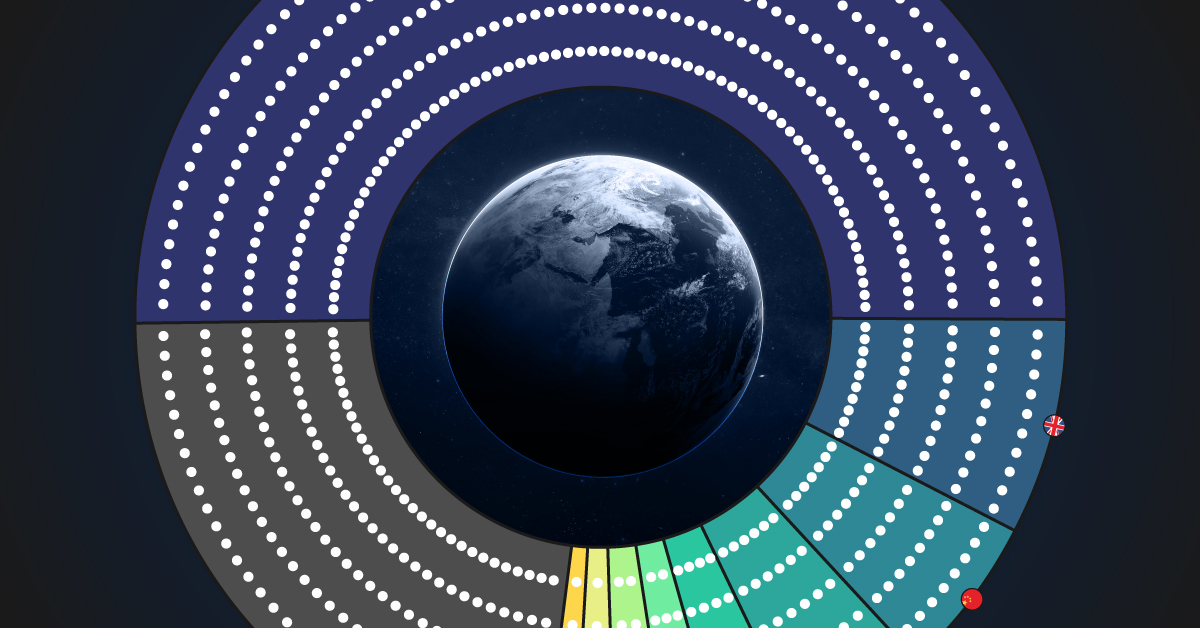
Which Companies Own the Most Satellites?
Nearly 7,000 satellites orbit the Earth, serving vital functions such as communication, navigation, and scientific research.
In 2022 alone, more than 150 launches took place, sending new instruments into space, with many more expected over the next decade.
But who owns these objects? In this graphic, we utilize data from the Union of Concerned Scientists to highlight the leaders in satellite technology.
SpaceX’s Dominance in Space
SpaceX, led by Elon Musk, is unquestionably the industry leader, currently operating the largest fleet of satellites in orbit—about 50% of the global total.
The company has already completed 62 missions this year, surpassing any other company or nation, and operates thousands of internet-beaming Starlink spacecraft that provide global internet connectivity.
Starlink customers receive a small satellite dish that self-orients itself to align with Starlink’s low-Earth-orbit satellites.
| Owner | Total | Share | Country |
|---|---|---|---|
| SpaceX | 3,395 | 50% | USA |
| OneWeb Satellites | 502 | 7% | UK |
| Chinese Government | 369 | 5% | China |
| U.S. Government | 306 | 4% | USA |
| Planet Labs, Inc. | 195 | 3% | USA |
| Russian Federation | 137 | 2% | Russia |
| Spire Global Inc. | 127 | 2% | USA |
| Swarm Technologies | 84 | 1% | USA |
| Iridium Communications, Inc. | 75 | 1% | USA |
| Other | 1,528 | 23% |
Percentages may not add to 100 due to rounding.
In second place is a lesser-known company, British OneWeb Satellites. The company, headquartered in London, counts the UK government among its investors and provides high-speed internet services to governments, businesses, and communities.
Like many other satellite operators, OneWeb relies on SpaceX to launch its satellites.
Despite Starlink’s dominance in the industry, the company is set to face intense competition in the coming years. Amazon’s Project Kuiper plans to deploy 3,236 satellites by 2029 to compete with SpaceX’s network. The first of the fleet could launch as early as 2024.
The Rise of China’s Space Program
After the top private companies, governments also own a significant portion of satellites orbiting the Earth. The U.S. remains the leader in total satellites, when adding those owned by both companies and government agencies together.
American expenditures on space programs reached $62 billion in 2022, five times more than the second one, China.
China, however, has sped up its space program over the last 20 years and currently has the highest number of satellites in orbit belonging directly to government agencies. Most of these are used for Earth observation, communications, defense, and technology development.
Satellite Demand to Rise Over the Decade
Despite the internet being taken for granted in major metropolitan areas and developed countries, one out of every three people worldwide has never used the web.
Furthermore, the increasing demand for data and the emergence of new, more cost-effective satellite technologies are expected to present significant opportunities for private space companies.
In this context, satellite demand is projected to quadruple over the next decade.
-

 Markets1 week ago
Markets1 week agoU.S. Debt Interest Payments Reach $1 Trillion
-

 Business2 weeks ago
Business2 weeks agoCharted: Big Four Market Share by S&P 500 Audits
-

 Real Estate2 weeks ago
Real Estate2 weeks agoRanked: The Most Valuable Housing Markets in America
-

 Money2 weeks ago
Money2 weeks agoWhich States Have the Highest Minimum Wage in America?
-

 AI2 weeks ago
AI2 weeks agoRanked: Semiconductor Companies by Industry Revenue Share
-

 Markets2 weeks ago
Markets2 weeks agoRanked: The World’s Top Flight Routes, by Revenue
-

 Demographics2 weeks ago
Demographics2 weeks agoPopulation Projections: The World’s 6 Largest Countries in 2075
-

 Markets2 weeks ago
Markets2 weeks agoThe Top 10 States by Real GDP Growth in 2023

